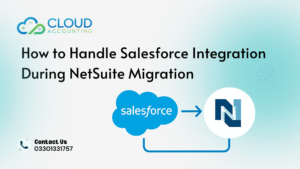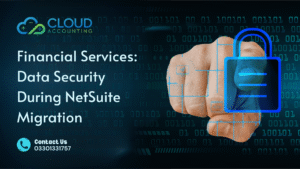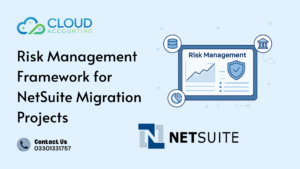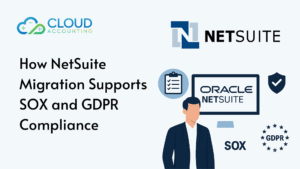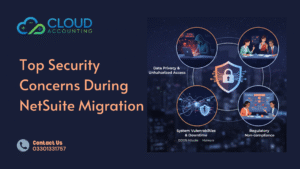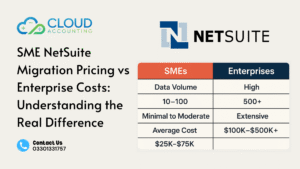When a company decides to move to NetSuite, it’s rarely a small decision. The platform can unify finance, operations, and reporting, but getting there isn’t always smooth. Many migrations run into data errors, integration failures, or delays that could have been prevented with a proper NetSuite Migration Risk Management plan.
Think of risk management as the guardrail that keeps your project on track. Without it, even experienced teams can face unexpected data loss, user confusion, or compliance gaps—issues that can cost months of productivity and thousands in recovery time.
In a large ERP transition like NetSuite, risk isn’t just technical—it’s strategic. A single weak control during data migration or user acceptance testing can ripple across the business, affecting reporting accuracy and financial compliance.
That’s why leading organizations treat NetSuite Migration Risk Management as a structured framework, not a reaction. By planning for what could go wrong before it happens, you can move faster, maintain control, and protect business continuity.
At Cloud Accounting, we help businesses navigate this process with a proven risk framework—covering data integrity, governance, and validation at every step. In this guide, we’ll unpack the key components of a strong risk management structure designed for successful NetSuite migrations.
Understanding NetSuite Migration Risk Management
Before diving into mitigation strategies, it’s important to understand what NetSuite Migration Risk Management actually covers. In essence, it’s a structured process that helps organizations anticipate, evaluate, and control potential issues that could derail a migration project.
Every NetSuite migration carries risk — whether it’s data errors, resource bottlenecks, or compliance concerns. The goal isn’t to eliminate risk entirely (that’s impossible), but to make it measurable, visible, and manageable.
In the context of NetSuite migration, risk management revolves around four main categories:
- Operational Risks: Delays caused by poor project planning, unclear roles, or resource conflicts.
- Data Risks: Errors during data extraction, transformation, or import that can lead to missing or duplicated records.
- Compliance Risks: Issues that arise from not meeting industry or regional regulations during migration—especially relevant for businesses operating under SOX, GDPR, or financial reporting standards.
- Change Management Risks: User resistance, lack of training, or inadequate communication about new workflows.
Effective NetSuite Migration Risk Management identifies which of these areas could affect your specific organization and prioritizes them based on likelihood and impact. This structured awareness allows teams to prepare mitigation steps long before a problem surfaces.
At Cloud Accounting, we see risk management as the backbone of a successful NetSuite implementation. It turns uncertainty into foresight and gives project teams the confidence to make informed decisions at every stage.
Common Risks in NetSuite Migration Projects
Every migration has its pressure points. Even with a strong plan, unexpected challenges can surface mid-project—especially if the team hasn’t applied a clear NetSuite Migration Risk Management strategy from the start.
Below are the most common risks that organizations face when moving to NetSuite and how they can quietly escalate if not addressed early.
1. Data Loss or Integrity Issues
The most frequent (and costly) problem in any migration is data inaccuracy. Incomplete mapping, incorrect field formatting, or skipped validation checks can lead to lost invoices, mismatched customer records, or unbalanced ledgers. Once bad data enters NetSuite, fixing it can be time-consuming and expensive.
A structured data validation process—central to NetSuite Migration Risk Management—helps catch these errors before they go live.
2. Integration Failures
Modern businesses rely on connected systems: CRMs, inventory apps, payroll platforms, and payment gateways. When one integration fails, it can disrupt workflows across multiple departments. The risk grows if integration testing is rushed or skipped. Ensuring that APIs and connectors are fully tested under real-world conditions is a key part of managing migration risk.
3. Inadequate Testing and Training
Testing is not just about running scripts—it’s about ensuring that your business processes still work after migration. If end users aren’t trained or if acceptance testing is shallow, small workflow changes can cause big problems post-launch.
A mature NetSuite Migration Risk Management plan allocates enough time for both testing and user readiness.
4. Scope Creep and Poor Governance
When new requirements keep getting added mid-project without proper review, you get “scope creep.” It’s one of the biggest reasons NetSuite migrations overshoot deadlines and budgets. Clear governance policies and change approval controls can prevent this by keeping all project decisions traceable and documented.
5. Compliance Gaps
Companies subject to SOX, GDPR, or local accounting standards face unique risks. Missing audit trails or improperly secured data transfers can trigger compliance violations. Incorporating compliance checks directly into your risk management framework ensures these standards are never compromised.
At Cloud Accounting, we’ve seen that identifying these common risks early doesn’t just save time—it protects reputation and financial accuracy. Each risk category requires proactive planning and ongoing monitoring to keep the migration on track.
Building a Risk Management Framework for NetSuite Migration
A successful migration doesn’t happen by luck—it’s engineered through structure and foresight. A well-defined NetSuite Migration Risk Management framework helps teams anticipate challenges before they disrupt operations.
Below is a four-step approach used by experienced ERP migration specialists, including our team at Cloud Accounting.
Step 1: Risk Identification
The first stage is all about visibility. You can’t manage what you haven’t identified.
At this point, teams should review every migration phase—data extraction, mapping, testing, integrations, and user onboarding—to spot potential weak points. Common tools include risk registers, team workshops, and checklists built around previous migration lessons.
The goal is to capture all potential risks, no matter how small, before they turn into real issues.
Step 2: Risk Assessment
Once the risks are listed, assess their likelihood and impact.
A “minor” issue like a missed data field might have low impact, but a failed integration with your billing system could halt operations. Using a standard risk matrix helps rank priorities clearly so project leads know where to focus resources.
This step creates the foundation for measurable NetSuite Migration Risk Management by distinguishing high-impact areas from manageable concerns.
Step 3: Risk Mitigation Planning
Here’s where strategy meets execution. Each identified risk needs a specific plan:
- Preventive controls (e.g., automating data validation scripts).
- Detective controls (e.g., post-migration reconciliation reports).
- Corrective controls (e.g., rollback procedures for failed imports).
Having documented mitigation measures ensures that when issues arise, your team responds instantly—without confusion or finger-pointing.
Step 4: Risk Monitoring and Control
Finally, risk management doesn’t end once NetSuite goes live. Risks evolve as the system scales.
Ongoing monitoring—through weekly project reviews, automated alerts, and reconciliation reports—keeps your migration health visible.
A real NetSuite Migration Risk Management framework turns into a living process: you track, adjust, and continuously improve based on lessons learned.
At Cloud Accounting, we apply this structured framework to every project. It creates accountability, transparency, and confidence that every migration will meet both operational and compliance standards—without last-minute surprises.
Practical Tools and Governance Models
Even the best risk framework needs the right tools and governance to support it. In NetSuite migration projects, poor oversight often leads to small issues snowballing into serious setbacks. That’s where structured governance and monitoring tools play a vital role in effective NetSuite Migration Risk Management.
1. Governance Frameworks That Work
Choosing the right project governance model gives your migration a defined command structure and accountability chain. Some of the most effective include:
- PMI or PRINCE2: Ideal for large organizations needing strict documentation, sign-offs, and change control.
- Agile Hybrid Models: Better for smaller or phased migrations, allowing faster iteration and feedback loops.
- RACI Matrix: Defines who is Responsible, Accountable, Consulted, and Informed—so decision-making doesn’t get lost in committee.
At Cloud Accounting, we often combine elements of these frameworks to fit a client’s size and complexity. The right mix ensures visibility without bureaucracy.
2. Risk Tracking and Escalation Tools
Your risk management framework is only as strong as your tracking system.
- Project Dashboards in tools like Asana, ClickUp, or Monday.com provide live visibility into task progress, dependencies, and overdue risk items.
- Risk Registers document every identified risk, its current status, owner, and next action.
- Escalation Protocols ensure that high-impact risks are flagged to leadership before they affect project outcomes.
These tools create accountability and help teams make proactive decisions, not reactive ones.
3. Approval and Quality Checkpoints
Establishing formal checkpoints—such as pre-migration data audits, integration approvals, and post-migration sign-offs—helps maintain control throughout the process.
Each checkpoint should have measurable criteria that determine whether the project moves forward or pauses for review. This “gated” approach is a cornerstone of NetSuite Migration Risk Management, keeping every stage verifiable and compliant.
4. Documentation and Audit Trails
A solid paper trail is more than just good practice—it’s a compliance requirement for industries under SOX or GDPR. Documentation should cover:
- Data migration logs
- Validation reports
- Change requests and approvals
- UAT and go-live sign-offs
Maintaining these records ensures your migration remains audit-ready, transparent, and defensible.
At Cloud Accounting, governance isn’t treated as red tape—it’s the safety net that guarantees project success. With clear structures, automation tools, and approval workflows in place, risk management becomes a predictable process instead of a guessing game.
Section 6: Role of Data Validation and Testing
Data is the backbone of every ERP system—and in a migration, it’s also the biggest source of potential risk. A single error in migration mapping or incomplete validation can create a chain reaction of financial and operational problems. That’s why NetSuite Migration Risk Management always prioritizes rigorous data validation and testing before, during, and after go-live.
1. Why Data Validation Matters
Data accuracy determines how well your new NetSuite environment performs. If legacy records are incomplete, duplicated, or misaligned, reports and dashboards will produce unreliable insights.
Validation ensures that every record—from invoices and vendor details to chart-of-accounts mappings—lands correctly in the new system.
At Cloud Accounting, our specialists use a phased validation approach:
- Pre-Migration Review: Clean and standardize legacy data before extraction.
- Mapping Verification: Match every legacy field to its correct NetSuite counterpart.
- Reconciliation Reports: Compare record counts and financial totals between systems after import.
Each step is logged and checked against control metrics to catch inconsistencies early.
2. Functional and Integration Testing
Testing isn’t just about seeing if data moved—it’s about confirming that your workflows still work.
Functional testing verifies that processes like invoicing, purchase orders, and reporting run as intended in NetSuite. Integration testing, on the other hand, ensures that connected systems (like CRMs or payment gateways) still exchange data correctly.
Neglecting these tests can lead to broken automation, delayed reporting, or compliance gaps—exactly what a NetSuite Migration Risk Management plan is designed to prevent.
3. User Acceptance Testing (UAT)
Even with perfect data and integration tests, user adoption can fail if employees aren’t comfortable using the system.
That’s where UAT comes in. It gives end users a chance to verify that the system aligns with daily operations before going live.
A good risk management plan schedules UAT sessions early and repeats them as necessary. The goal is to build confidence, not just compliance.
4. Post-Migration Validation
Once NetSuite is live, it’s vital to perform post-migration checks. These include trial balance comparisons, report verification, and spot audits on key transaction types.
By comparing pre- and post-migration outputs, teams can confirm that all critical financial data remains accurate—closing the loop in the NetSuite Migration Risk Management cycle.
At Cloud Accounting, we treat testing as a safeguard, not an afterthought. Each phase of data validation adds a layer of protection, ensuring your NetSuite environment performs reliably from day one.
Final Thoughts
NetSuite migration isn’t just a technical upgrade—it’s a business transformation. And like any major change, it comes with uncertainty. The difference between a smooth transition and a costly recovery effort lies in one thing: how well you manage risk.
A mature NetSuite Migration Risk Management framework gives your team clarity, accountability, and control. It ensures that data remains accurate, integrations stay stable, and compliance never falls through the cracks. Most importantly, it builds confidence across your organization that the migration will deliver the results promised.
Too often, businesses only think about risk management after something goes wrong—when invoices disappear, or reports don’t balance. But proactive planning turns risk into foresight. It empowers teams to act before problems surface, saving time, money, and frustration.
At Cloud Accounting, we integrate risk management into every NetSuite migration we handle. From initial data analysis to post-go-live monitoring, our process is designed to safeguard your data integrity and operational continuity.
If you’re planning a migration or already mid-project and want to strengthen your control measures, now’s the time to act. Our specialists can assess your project’s risk exposure and build a tailored mitigation framework that keeps your business secure at every stage.
Don’t leave your migration to chance. Book a NetSuite Migration Risk Assessment with Cloud Accounting today and gain a clear roadmap to a safer, faster transition.


